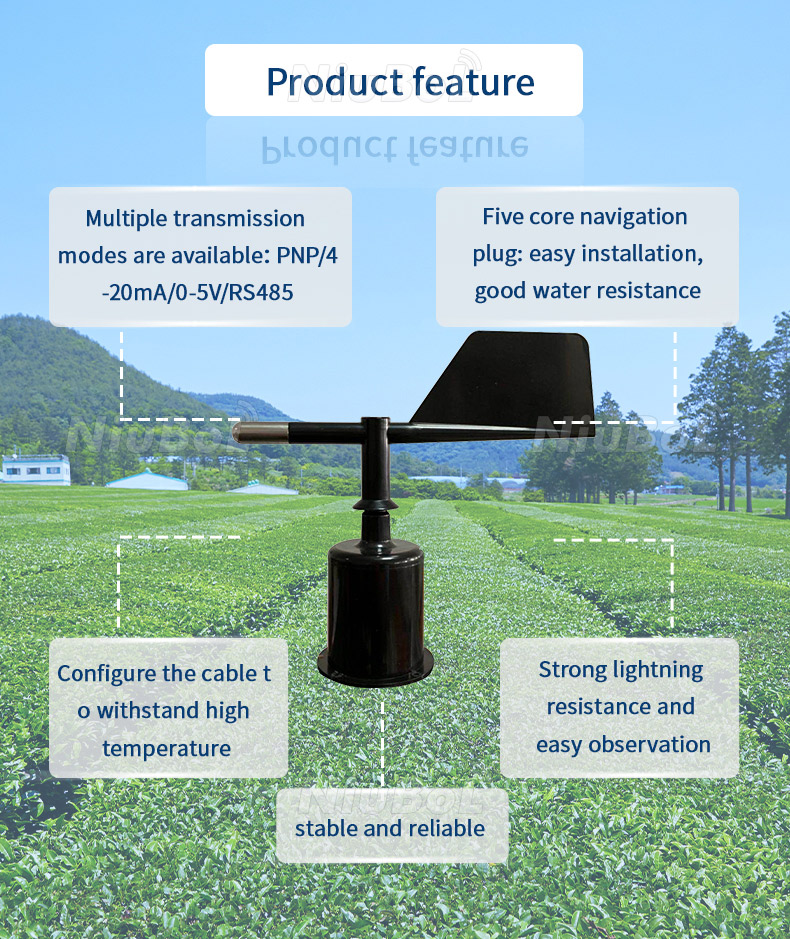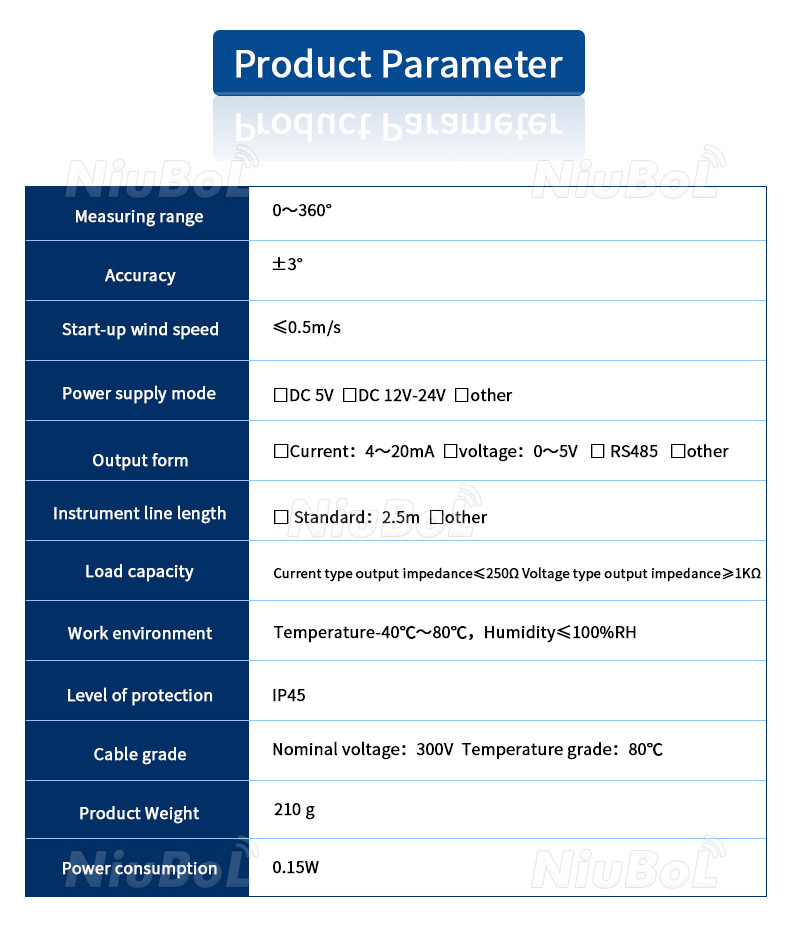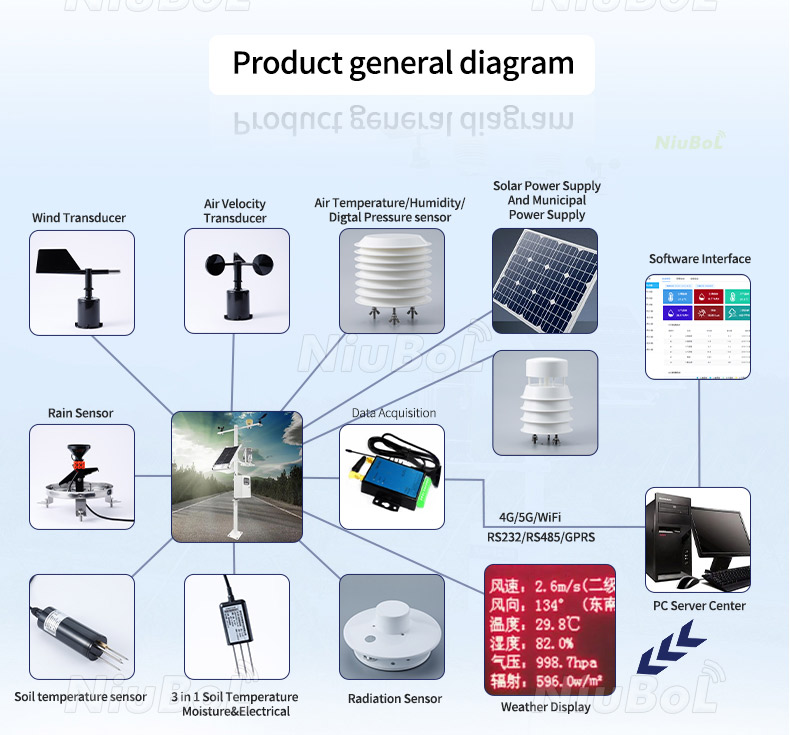

— Blogs —
—Products—
 Consumer hotline +8618073152920
Consumer hotline +8618073152920 WhatsApp:+8615367865107
Address:Room 102, District D, Houhu Industrial Park, Yuelu District, Changsha City, Hunan Province, China
Product knowledge
Time:2023-12-18 22:03:33 Popularity:2244
The wind direction sensor is a physical device that detects and senses the external wind direction information through the rotation of the wind direction arrow, and transmits it to the coaxial code dial, and outputs the corresponding wind direction correlation value. It is widely used in meteorology, Marine, environment, agriculture, forestry, water conservancy, electric power, scientific research and other fields, and is usually used together with wind speed sensors.
The principle of the mechanical wind direction sensor is to use the principle of aerodynamics, that is, when the wind blows on the object, it creates a pressure difference, which causes the object to deflect or rotate. Its structure is usually composed of a signature direction pointer, an impeller or a wind blade that follows the wind direction. Under the action of the wind, the wind blade will produce a swing from the central axis, and then drive the direction pointer to the direction of the wind.
The electronic wind direction sensor uses electronic technology to measure the wind direction. It usually consists of a series of devices, including wind direction sensors, signal processing units, output devices, etc. Wind direction sensors usually use wind pressure or wind vibration sensors, the latter by detecting the degree of vibration caused by the wind blowing through the aluminum wing, so as to obtain wind direction information. The signal processing unit digitizes the wind direction data collected by the sensor and outputs it to the monitoring system or data acquisition terminal through the interface to provide real-time wind direction information.

Mechanical wind direction sensor and electronic wind direction sensor advantages and disadvantages:
Mechanical wind direction sensors and electronic wind direction sensors have advantages and disadvantages, and the specific choice depends on the application scenario and needs.
The mechanical wind direction sensor has the advantages of simple structure, long service life and cheap price, but its measurement accuracy and response speed are relatively low. It is suitable for occasions where the accuracy is not high, such as meteorological observation and agricultural wind direction measurement.
The electronic wind direction sensor has the advantages of high measurement accuracy, fast response speed and long service life, but its price is relatively high. It is suitable for applications requiring high precision, such as industrial automation, aerospace and other fields.
As for the price, the price of mechanical wind direction sensors is relatively low, while the price of electronic wind direction sensors is higher. The specific price needs to be determined according to different brands, models, specifications and other factors.

The application scenario of wind direction sensor is very wide, mainly including the following aspects:
1. Meteorological observation and environmental monitoring: Wind direction sensor is one of the indispensable equipment in meteorological observation and environmental monitoring. It can measure near-earth wind direction in outdoor environment, provide accurate wind direction data for meteorological departments, help predict weather changes, and provide support for environmental protection and meteorological disaster early warning.
2. Wind power: Wind direction sensors are also widely used in the field of wind power. It can measure changes in wind speed and direction, providing real-time wind direction data for the wind turbine to ensure the normal operation and maximum efficiency of the generator.

3. Marine meteorological early warning: In the Marine meteorological early warning system, the wind direction sensor can provide real-time wind direction data for the system, help predict the coverage of typhoon and the "operation" track, and provide security for Marine navigation, fishery production and Marine resource development.
4. Agricultural field: In agricultural production, wind direction sensors can monitor wind direction changes in farmland environment and provide data support for agricultural planting and meteorological disaster warning. At the same time, it can also be used to study the relationship between wind direction and crop growth and yield, and provide scientific basis for agricultural production.
5. Smart city and intelligent transportation: In the field of smart city and intelligent transportation, wind direction sensors can be used to monitor wind direction changes in urban environment and traffic conditions, providing data support for urban planning and traffic management.
To sum up, the choice of wind direction sensor needs to be determined according to actual needs and application scenarios. If the accuracy requirements are not high, and the budget is limited, you can choose a mechanical wind direction sensor; If the accuracy requirements are high, and the budget is sufficient, you can choose an electronic wind direction sensor.


Wind direction measurement: The wind direction sensor can measure the direction of the wind and provide accurate wind direction data for meteorological observation, environmental monitoring, wind power generation and other fields.
Weather prediction: By measuring the wind direction, you can predict the change of the weather, provide important meteorological information for the meteorological department, and help people do a good job in the prevention and response to meteorological disasters.
Improve energy efficiency: In the field of wind power generation, wind direction sensors can provide real-time wind direction data to help wind turbines adjust the Angle and operating status to improve energy efficiency.
Ensure safety: In aviation, navigation, weather warning and other fields, accurate wind direction data is essential to ensure safety. Wind sensors can help pilots or automatic navigation systems make adjustments to ensure safe navigation.
Promote scientific research: Wind direction sensors also play an important role in the research of meteorology, environment, agriculture and other fields. By measuring the wind direction, we can study the impact of wind on the environment, explore the meteorological conditions of agricultural production, etc., and provide important data support for scientific research.
In short, wind direction sensors have a wide range of applications in various fields, and are of great significance for improving people's quality of life, promoting economic development and scientific research.
Weather-Stations-Catalog-NiuBoL-2024.pdf
Related recommendations
Sensors & Weather Stations Catalog
Agriculture Sensors and Weather Stations Catalog-NiuBoL.pdf
Weather Stations Catalog-NiuBoL.pdf
Related products
 Combined air temperature and relative humidity sensor
Combined air temperature and relative humidity sensor Soil Moisture Temperature sensor for irrigation
Soil Moisture Temperature sensor for irrigation Soil pH sensor RS485 soil Testing instrument soil ph meter for agriculture
Soil pH sensor RS485 soil Testing instrument soil ph meter for agriculture Wind Speed sensor Output Modbus/RS485/Analog/0-5V/4-20mA
Wind Speed sensor Output Modbus/RS485/Analog/0-5V/4-20mA Tipping bucket rain gauge for weather monitoring auto rainfall sensor RS485/Outdoor/stainless steel
Tipping bucket rain gauge for weather monitoring auto rainfall sensor RS485/Outdoor/stainless steel Pyranometer Solar Radiation Sensor 4-20mA/RS485
Pyranometer Solar Radiation Sensor 4-20mA/RS485
Screenshot, WhatsApp to identify the QR code
WhatsApp number:+8615367865107
(Click on WhatsApp to copy and add friends)
